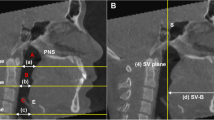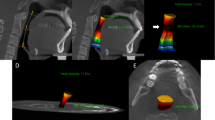Abstract
Introduction
The aim of this study was to evaluate pharyngeal airway changes in adult skeletal Class III cases whose bimaxillary surgical treatments were planned with different amounts of maxillary and mandibular movement using lateral cephalometric radiographs and finite element analysis (FEA). Our null hypothesis was that bimaxillary orthognathic surgery in which maxillary forward movement (MF) is greater than mandibular backward movement (MB) will result in more expansion of the pharyngeal airway.
Materials and Methods
A total of 31 individuals (11 females, 20 males) with class III skeletal deformity were included in the study. Patients who underwent bimaxillary orthognathic surgery with greater maxillary advancement (MF > MB) were categorized in Group 1 (n = 15), and those with greater mandibular set-back (MB > MF) as Group 2 (n = 16). Changes in airway dimensions were evaluated from lateral cephalometric radiographs. In addition, FEA modeling was used to determine pharyngeal airway changes with 5 different MF/MB combinations performed in skeletal class III bimaxillary surgeries.
Results
Nasopharyngeal and oropharyngeal airway dimensions increased in direct proportion to the amount of MF. Hypopharyngeal volume decreased compared to preoperative value in direct proportion to the decrease in MB. According to the FEA models, total pharyngeal airway volume decreased when MF was less than or equal to MB, was nearly unchanged when MF was 2 mm greater than MB, and increased when MF was 4 mm greater than MB. The results of FEA and lateral cephalometric analysis were compatible.
Conclusion
Our results supported the null hypothesis. We concluded that when possible, planning slightly more maxillary advancement than mandibular set-back will not have an adverse impact on the airway. Although the skeletal deformity only causes forward displacement of the mandible, dividing the skeletal correction between the maxilla and mandible may be considered to avoid the risk to patients’ quality of life in terms of respiratory function.






Similar content being viewed by others
Data Availability
The datasets used and/or analyzed during the current study are available from the corresponding author on reasonable request.
Abbreviations
- FEA:
-
Finite element analysis
- MF:
-
Maxillary forward
- MB:
-
Mandibular backward
- 2D:
-
Two dimension
- 3D:
-
Three dimension
- CBCT:
-
Cone beam computed tomography
- SN:
-
Sella-Nasion Line
- APL:
-
Nasopharyngeal and oropharyngeal anteroposterior length
- LTW:
-
Oropharyngeal, nasopharyngeal and hypopharyngeal largest transverse width
- CSA:
-
Cross sectional area
- NPV:
-
Nasopharyngeal volume
- HPV:
-
Hypopharyngeal volume
- OPV:
-
Oropharyngeal volume
References
Boutremans E, Sm Rey, Loeb I (2008) Management of patient with sleep apnea syndrome. Rev Med Brux 29:277–80
Abramson Z, Susarla SM, Lawler M, Bouchard C, Troulis M, Kaban LB (2011) Three dimensional computed tomographic 280 airway analysis of patients with obstructive sleep apnea treated by maxillomandibular advancement. J Oral Maxillofac Surg 69:677–86
Muto T, Yamazaki A, Takeda S, Sato Y (2008) Effect of bilateral sagittal split ramus osteotomy setback on the soft palate and pharyngeal airway space. Int J Oral Maxillofac Surg 37:419–423
Mattos CT, Vilani GN, Sant’anna EF, Ruellas AC, Maia LC (2011) Effects of orthognathic surgery on oropharyngeal airway: a metaanalysis. Int J Oral Maxillofac Surg 40:1347–56
Hasebe D, Kobayashi T, Hasegawa M, Iwamoto T, Kato K, Izumi N et al (2011) Changes in oropharyngeal airway and respiratory function during sleep after orthognathic surgery in patients with mandibular prognathism. Int J Oral Maxillofac Surg 40:584–592
Gregory H, Otterloo J, Nanda R (1994) Long-term stability and prediction of soft tissue changes after LeFort I surgery. Am j orthod dentofac orthop 104:544–55
Mobarak KA, Espeland L, Krogstad O, Lyberg T (2001) Soft tissue profile changes following mandibular advancement surgery: predictability and long-term outcome. Am J Orthod Dentofac Orthop 119:353–367
Aydemir H, Memikoğlu U, Karasu H (2012) Pharyngeal airway space, hyoid bone position and head posture after orthognathic surgery in Class III patients. Angle Orthod 82:993–1000
Sears CR, Miller AJ, Chang MK, Huang JC, Lee JS (2011) Comparison of pharyngeal airway changes on plain radiography and cone-beam computed tomography after orthognathic surgery. J Oral Maxillofac Surg 69:e385-394
Chang MK, Sears C, Huang JC et al (2015) Correlation of airway volume with orthognathic surgical movement using cone-beam computed tomography. J Oral Maxillofac Surg 73:S67
Schendel SA, Broujerdi JA, Jacobson RL (2014) Three-dimensional upper-airway changes with maxillomandibular advancement for obstructive sleep apnea treatment. Am J Orthod Dentofacial Orthop 146:385
Gokce SM, Gorgulu S, Gokce HS et al (2014) Evaluation of pharyngeal airway space changes after bimaxillary orthognathic surgery with a 3-dimensional simulation and modeling program. Am J Orthod Dentofacial Orthop 146:477
Lee UL, Oh H, Min SK, Shin JH, Kang YS, Lee WW, Han YE, Choi YJ, Kim HJ (2017) The structural changes of upper airway and newly developed sleep breathing disorders after surgical treatment in class III malocclusion subjects. Medicine 96(22):e6873
Hart PS, McIntyre P, Kadioglu O, Currier GF, Sullivan SM, Li J, Shay C (2015) Postsurgical volumetric airway changes in 2-jaw orthognathic surgery patients. Am J Orthod Dentofacial Orthop 147:536–546
Efendiyeva R, Aydemir H, Karasu H, Toygar-Memikoglu U (2014) Pharyngeal airway space, hyoid position, and head posture after bimaxillary orthognathic surgery in Class III patients Long-term evaluation. Angle Orthod 84:773–781
Uslu-Akçam Ö, Gökalp H (2015) Tongue size and posterior airway space changes in class III malocclusion after maxillomandibular surgery: a retrospective study. Int J Orthodontics 26(4):47–43
Shah DH, Kim KB, McQuilling MW et al (2016) Computational fluid dynamics for the assessment of upper airway changes in skeletal Class III patients treated with mandibular setback surgery. Angle Orthod 86:976
Sprenger R, Martins LAC, Dos Santos JCB et al (2017) A retrospective cephalometric study on upper airway spaces in different facial types. Prog Orthod 18:25
Franco FC, de Araujo TM, Vogel CJ, Quintão CC (2013) Brachycephalic, dolichocephalic and mesocephalic: is it appropriate to describe the face using skull patterns? Dental Press J Orthod 18:159
Panou E, Motro M, Ateş M, Acar A, Erverdi N (2013) Dimensional changes of maxillary sinuses and pharyngeal airway in Class III patients undergoing bimaxillary orthognathic surgery. Angle Orthod 85:1–8
Pereira-Filho VA, Castro-Silva LM, de Moraes M et al (2011) Cephalometric evaluation of pharyngeal airway space changes in class III patients undergoing orthognathic surgery. J Oral Maxillofac Surg 69(11):e409–e415
Hatab NA, Konstantinovic VS, Mudrak JKH (2015) Pharyngeal airway changes after mono- and bimaxillary surgery in skeletal class III patients: cone-beam computed tomography evaluation. J Craniomaxillofac Surg 43:491–496
Vaezi T, Zarch S, Eshghpour M, Kermani H (2017) Two-dimensional and volumetric airway changes after bimaxillary surgery for class III malocclusion. J Korean Assoc Oral Maxillofac Surg 43:88. https://doi.org/10.5125/jkaoms.2017.43.2.88
Okano T, Harata Y, Sugihara Y, Sakaino R, Tsuchida R, Iwai K et al (2009) Absorbed and effective doses from cone beam volumetric imaging for implant planning. Dentomaxillofac Radiol 38:79–85
Park SB, Kim YI, Son WS, Hwang DS, Cho BH (2012) Cone-beam computed tomography evaluation of short- and long-term airway change and stability after orthognathic surgery in patients with Class III skeletal deformities: bimaxillary surgery and mandibular setback surgery. Int J Oral Maxillofac Surg 41:87–93
Demetriades N, Chang DJ, Laskarides C, Papageorge M (2010) Effects of mandibular retropositioning, with or without maxillary advancement, on the oro-naso-pharyngeal airway and development of sleep-related breathing disorders. J Oral Maxillofac Surg 68:2431
Christovam IO, Lisboa CO, Ferreira DMTP et al (2016) Upper airway dimensions in patients undergoing orthognathic surgery: a systematic review and meta-analysis. Int J Oral Maxillfac Surg 45:460
Camacho M, Capasso R, Schendel S (2014) Airway changes in obstructive sleep apnoea patients associated with a supine versus an upright position examined using cone beam computed tomography. J Laryngol Otol 128:824
Becker OE, Avelar RL, Göelzer JG, Dolzan Ado N, Haas Jr OL, De Oliveira RB (2012) Pharyngeal airway changes in Class III patients treated with double jaw orthognathic surgery—maxillary advancement and mandibular setback. J Oral Maxillofac Surg 70:e639–e647
Saitoh K (2004) Long-term changes in pharyngeal airway morphology after mandibular setback surgery. Am J Orthod Dentofac Orthop 125:556–561s
Eggensperger N, Smolka W, Iizuka T (2005) Long-term changes of hyoid bone position and pharyngeal airway size following mandibular setback by sagittal split ramus osteotomy. J Cranio-Maxillofac Surg 33(2):111–117
Zinser MJ, Zachow S, Sailer HF (2013) Bimaxillary “rotation advancement” procedures in patients with obstructive sleep apnea: a 3-dimensional airway analysis of morphological changes. Int J Oral Maxillofac Surg 42(5):569–578
Lisiak-Myszke M, Marciniak D, Bieliński M, Sobczak H, Garbacewicz Ł, Drogoszewska B (2020) application of finite element analysis in oral and maxillofacial surgery—a literature review. Materials 13(14):3063
Mansour KF, Rowley JA, Safwan BM (2006) Measurement of pharyngeal cross-sectional area by finite element analysis. J Appl Physiol 100(1):294–303
Funding
This research was supported by Ankara University Scientific Research Projects Coordination. Project Number 16L0234004.
Author information
Authors and Affiliations
Contributions
CA and ATA carried out the study design, data collection, and statistical analysis and drafted the manuscript. CA and NCE treated the patients and acquired the data. NCE conceived the study and participated in its design, coordination, and manuscript writing. The authors read and approved the final manuscript.
Corresponding author
Ethics declarations
Conflict of interest
All the authors that they have no conflict of interest.
Ethical Approval
Ethical approval of this study was obtained from Ankara University Faculty of Dentistry Clinical Research Ethics Committee (36290600/11).
Consent for Publication
Not applicable
Additional information
Publisher's Note
Springer Nature remains neutral with regard to jurisdictional claims in published maps and institutional affiliations.
Rights and permissions
Springer Nature or its licensor holds exclusive rights to this article under a publishing agreement with the author(s) or other rightsholder(s); author self-archiving of the accepted manuscript version of this article is solely governed by the terms of such publishing agreement and applicable law.
About this article
Cite this article
Ceylan Eser, N., Arslan, C. & Altuğ, A.T. Validation of a Finite Element Model for Clinical and Virtual Evaluation of the Changes in Airway Dimensions Following Class III Bimaxillary Orthognathic Surgery. J. Maxillofac. Oral Surg. 22, 217–225 (2023). https://doi.org/10.1007/s12663-022-01781-8
Received:
Accepted:
Published:
Issue Date:
DOI: https://doi.org/10.1007/s12663-022-01781-8




